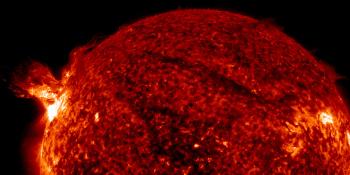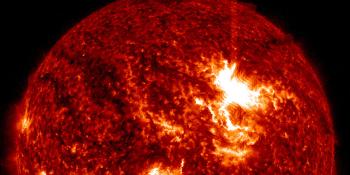Space Weather Forecast - Discussion
Issued: 2025 Dec 05 0030 UTC
Prepared by the U.S. Dept. of Commerce, NOAA, Space Weather Prediction Center and processed by SpaceWeatherLive.com
Solar activity
24 h Summary
Solar activity reached high levels. Region 4300 (N07E28, Dao/beta-delta) produced an impulsive M6.0/1F (R2-Moderate) flare at 04/0250 UTC. Associated with the flare was a Type-II radio sweep (est. 345 km/s) and CME signature in subsequent coronagraph imagery beginning at 04/0312 UTC in SOHO/LASCO C2. CME analysis and model output suggested no Earth-directed component. A Type-IV radio sweep may have been associated with a CME originating from the SE quadrant, first observed in C2 imagery at 04/0648 UTC, in the vicinity of Region 4296 (S14E23, Ekc/beta-gamma-delta). Modelling of the event suggested the periphery of the CME may pass Earth late on 07 Dec. Growth was observed in Region 4301 (S07W58, Dai/beta). Slight decay was observed in Region 4294 (S15E04, Fkc/beta-gamma-delta) and Region 4296 (S14E23, Ekc/beta-gamma-delta). A new region of emerging flux was observed in the SW quadrant. Only minor changes were observed in other numbered active regions on the visible disk.Forecast
M-class flares are expected (75%) through 07 Dec, with a chance for X-class flares (30%), given past flare history and the potential of current active regions on the disk.Energetic Particles
24 h Summary
The greater than 2 MeV electron flux in geosynchronous orbit was at normal to moderate levels. The greater than 10 MeV proton flux in geosynchronous orbit remained at background levels.Forecast
The greater than 2 MeV electron flux is expected to remain at moderate levels on 05 Dec. High levels are likely on 06-07 Dec due to elevated solar wind speeds associated with the ongoing CH HSS. A slight chance (15%) exists for a greater than 10 MeV proton flux enhancement above 10 pfu (S1-Minor) through 07 Dec due to the eruptive potential of multiple active regions across the visible disk.Solar Wind
24 h Summary
Solar wind parameters reflected the transition from CIR to negative polarity CH HSS influences. Total magnetic field strength decreased from a peak of 20 nT at the beginning of the reporting period to 7-9 nT after 04/0430 UTC. Bz briefly reached as far south as -14 nT at 04/0226 UTC. Solar wind speeds increased to a peak just above 700 km/s at 04/0450 UTC, before gradually waning in the hours the followed. Phi was predominantly oriented in a negative solar sector.Forecast
The solar wind environment is anticipated to remain disturbed by the negative polarity CH/HSS influences over 05-07 Dec. An additional enhancement is likely late on 07 Dec due to glancing effects from the 04 Dec CME.Geospace
24 h Summary
Geomagnetic activity reached G1 (Minor) geomagnetic storm levels early in the period due to coronal hole influences.Forecast
The geomagnetic field is likely to reach active levels, with a chance for G1 (Minor) storm levels, over 05-06 Dec as influence from the coronal hole wanes. G1 geomagnetic storm levels are likely on 07 Dec due to the anticipated onset of influence from the periphery of a CME that left the Sun on 04 Dec.Latest news
Latest forum messages
Space Weather Memes 760AR4294 / 4296 / 4298 290Current Farside Activity 233AR 4299 23Unspecified geomagnetic activity 36
More topicsSupport SpaceWeatherLive.com!
A lot of people come to SpaceWeatherLive to follow the Solar activity or if there is a chance to see the aurora, but with more traffic comes higher costs to keep the servers online. If you like SpaceWeatherLive and want to support the project you can choose a subscription for an ad-free site or consider a donation. With your help we can keep SpaceWeatherLive online!
Space weather facts
| Last X-flare | 2025/12/01 | X1.9 |
| Last M-flare | 2025/12/04 | M6.0 |
| Last geomagnetic storm | 2025/12/04 | Kp5 (G1) |
| Spotless days | |
|---|---|
| Last spotless day | 2022/06/08 |
| Monthly mean Sunspot Number | |
|---|---|
| October 2025 | 114.6 -15.2 |
| December 2025 | 186 +71.4 |
| Last 30 days | 106.3 +12.6 |





